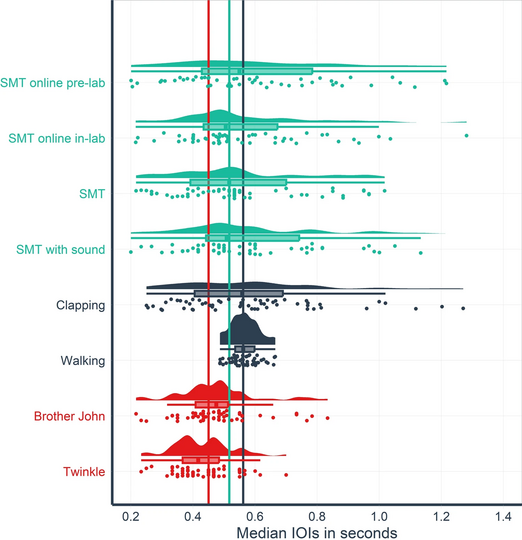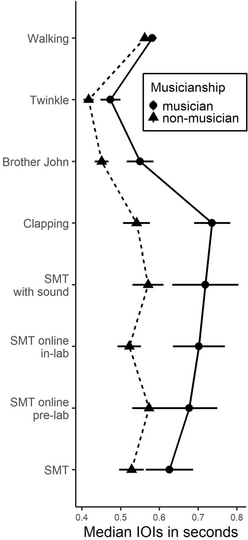Do we have a natural rhythm?
Many of us perform spontaneous rhythmic behaviors every for example when we walk or clap. But are the rates at which be perform these behaviors related to each other and which factors influence at which rates we perform spontaneous rhythmic movements? Researchers from Aarhus University and Paris Lodron University of Salzburg investigated this in a recent study at COBE Lab.
The tasks
Participants completed eight small tasks designed to measure different spontaneous movements. During the variations of the SMT task, participants tapped their fingers at spontaneous and comfortable rates. The SRP task was a similar finger tapping task, however participants tapped the melodies of two known songs. Below you can view the tasks and instructions the participants received.
| Task | Device | Instructions |
|---|---|---|
| SMT online pre-lab | Smartphone/Laptop/Tablet | Using the index finger of your dominant hand, please tap at a steady rate that feels comfortable to you |
| SMT online in-lab | Same as above | Same as above |
| SMT | Metal plate | Same as above |
| SMT with sound | Same as above | Same as above |
| SRP: Brother John | Same as above | Please play the song using the index finger of your dominant hand |
| SRP: Twinkle | Same as above | Same as above |
| Walking | Audio recorder | Please walk at a steady rate that feels comfortable to you, put your hands on the wall, and walk back |
| Clapping | Same as above | Please clap your hands together at a steady rate that feels comfortable to you |
Participants
59 participants participated in this study. They included a mixture of musicians and non-musicians because musicianship has been suggested to influence the rate of spontaneous rhythmic behaviors. They measured musicianship on Ollen's Musical Sophistication Index, where people choose which title best describes them among 'non-musician', 'music-loving non-musician', 'amateur musician', 'serious amateur musician', 'semiprofessional musician' and 'professional musician'.
Results
The researchers first investigated whether the different measures of spontaneous rhythmic movements are related to each other. They found that the different measures of spontaneous rhythmic movements correlated with each other which suggests that individuals have a natural rhythm that determines the rate of their spontaneous rhythmic behaviors. This means that the rates that the participants tapped, clapped and walked were highly similar across all tasks.


Second, the researchers investigated whether musicianship influences the rate of spontaneous rhythmic movements. They found that the musicians' rates were more consistent across all tasks compared to the non-musicians'. They also found that the musicians' rate were overall slower across all tasks compared to the non-musicians'. The results therefore suggest that musicianship does influence the rate of spontaneous rhythmic movements.
Conclusions
The researchers suggest that spontaneous rhythmic movement are related in a hierarchy of at least three levels.
Level 1: shared mechanism for performing spontaneous movements
Level 2: shared effector system
Level 3: cognitive constraints
According to the first level, all spontaneous movements are produced by the same mechanism in the brain. According to the second level, spontaneous movements are related according to the effector system in use. The tapping tasks all share the same biomechanical system whereas the clapping and walking tasks are separate systems. Finally, according to the third level, the melody tapping tasks share cognitive constraints because the melodies need to be tapped within a certain range of rates to recognizable. This is for example reflected in the results by that the tapping tasks are all correlated but the correlation for the melody tasks and the other tapping tasks is less strong than that between the tapping tasks internally. At the same time, the melody tapping tasks are strongly correlated.
If the same neural mechanism produces all spontaneous rates and these share a natural rhythm, it is has implications for our perception and action generally. This research therefore points to a very central aspect of our cognition, namely how we coordinate with external events.
This research was published in 2024 in Nature Scientific Reports and titled 'Spontaneous rates exhibit high intra-individual stability across movements involving different biomechanical systems and cognitive demands'. Click on the link to read the paper.
The short story
- The rates at which we produce spontaneous rhythmic movements are related to each other. This means that we generally clap and walk in the same tempo as we tap our fingers.
- Musicianship influences these rates. Musicians generally perform these movements at slower rates and are generally more consistent across tasks, meaning they for example clap and tap in similar tempos.
The researchers
- Ben Engler: Department of Psychology, Centre for Cognitive Neuroscience, Paris Lodron University of Salzburg, Salzburg, Austria. Center for Music in the Brain, Department of Clinical Medicine, Aarhus University and the Royal Academy of Music Aarhus/Aalborg, Aarhus, Denmark.
- Anna Zamm: Department of Linguistics, Cognitive Science and Semiotics, Aarhus University, Aarhus, Denmark.
- Cecilie Møller: Center for Music in the Brain, Department of Clinical Medicine, Aarhus University and the Royal Academy of Music Aarhus/Aalborg, Aarhus.